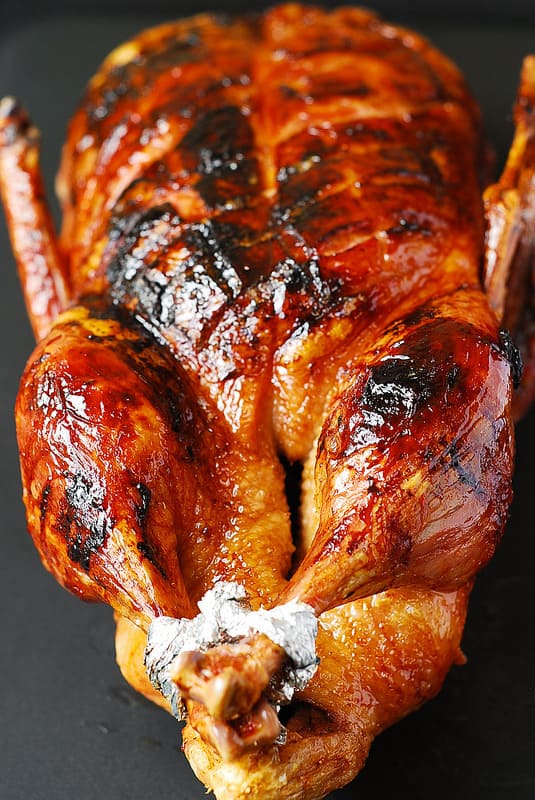Duck
From Alton Brown, Good Eats The Early Years (with minor changes)
Serves 2 – 4 (appetite dependent)
Ingredients
1/2 cup kosher salt
1 pint pineapple/orange juice
15 whole peppercorns
1 sprig fresh thyme (or 1 teaspoon dried thyme)
4 crushed garlic cloves (or 4 teaspoons garlic powder)
1 Long Island/Pekin duck (about 6 pounds)
Directions
Combine the salt, juice, peppercorns, thyme, and garlic in a sealable plastic container. Seal and shake until the salt is dissolved. Set the brine aside. Line the inside of another container or pot with a gallon-size zip-top bag. Remove the pop-up timer (if installed), liver, gizzard, heart, and anything else from inside the duck. Cut off the wings at the elbow with a knife or shears. Place the bird breast side down and find the spine at the base of the neck. Use shears to cut down one side of the backbone to the tail. Turn and make a return cut up the other side. Remove the backbone. Turn the duck over and cut straight down the middle of the breastbone, thus splitting the bird in half. To separate the legs, use a boning knife to make a crescent-shaped cut around the leg. Lift the duck half in the air using the leg as a handle so that the thigh joint opens up. Cut straight through from front to back. Trim away any extra unwanted skin. With your shears cut 6 to 10 small slits through the skin on each duck quarter without cutting through the subcutaneous fat (under the skin) to the meat below. Place the duck quarters inside the gallon bag and pour in the brine. Seal the bag, removing as much of the air as possible. Refrigerate for 2 to 2 1/2 hours. When you're ready to cook, bring a couple of inches of water to a boil in a large (say, 8-quart) pot. Place a metal colander or a steamer insert into the pot and line it with the duck pieces, cut sides down. Cover the pot. Reduce the heat to maintain a simmer. Steam the duck gently for 45 minutes to render some of the fat; the duck won't be completely cooked through at this point. Place a 12-inch cast-iron skillet or griddle in the oven and heat the oven to 475°F. Remove the duck pieces from the colander (don't dare throw out the water—see below) and carefully place them skin side down in the hot skillet. Return the skillet or griddle to the oven and roast for 10 minutes. Carefully flip the pieces and cook for another 12 to 15 minutes, or until the skin is deep mahogany and very crisp. Remove the duck from the skillet and set aside to rest for 10 minutes, loosely covered with aluminum foil.
Note #1 – The wings pieces, back, neck, giblets and any extraneous skin that has been removed can be made into a stock for gravy or soup. Be sure to cool/freeze to remove the duck fat.
Note #2 – The water that was used to steam the duck is excellent as a soup stock. Be sure to cool/freeze to remove the duck fat.
Note #3 – Save the duck fat after removing from the liquids. It makes excellent frying fat or even as a spread on bagels


